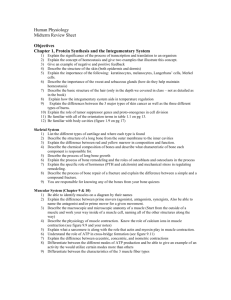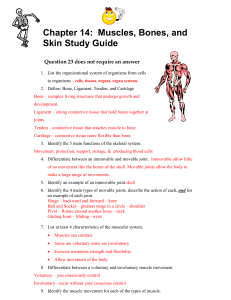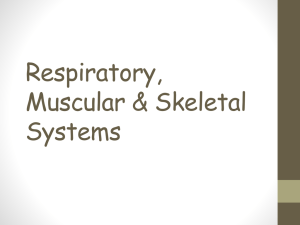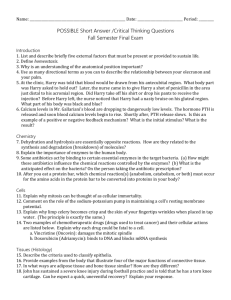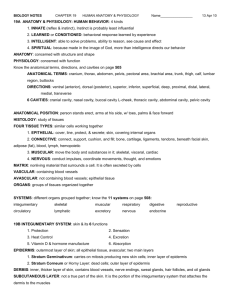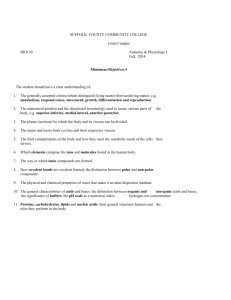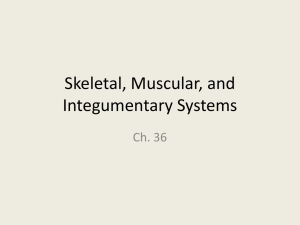Sem 1 Final Review
advertisement
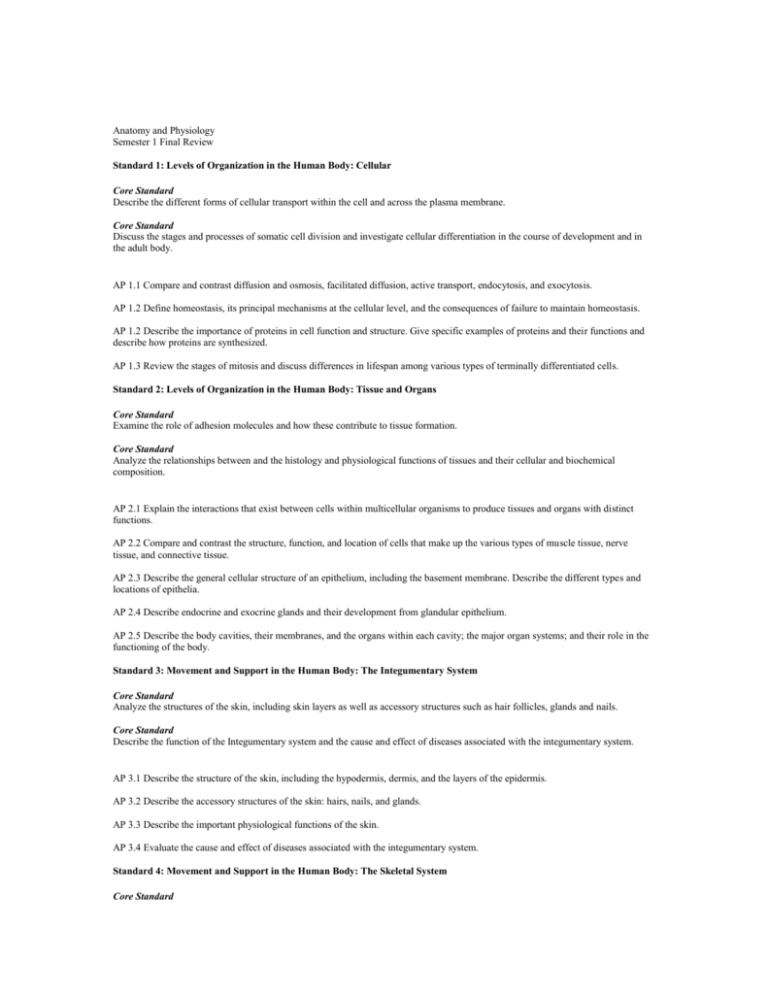
Anatomy and Physiology Semester 1 Final Review Standard 1: Levels of Organization in the Human Body: Cellular Core Standard Describe the different forms of cellular transport within the cell and across the plasma membrane. Core Standard Discuss the stages and processes of somatic cell division and investigate cellular differentiation in the course of development and in the adult body. AP 1.1 Compare and contrast diffusion and osmosis, facilitated diffusion, active transport, endocytosis, and exocytosis. AP 1.2 Define homeostasis, its principal mechanisms at the cellular level, and the consequences of failure to maintain homeostasis. AP 1.2 Describe the importance of proteins in cell function and structure. Give specific examples of proteins and their functions and describe how proteins are synthesized. AP 1.3 Review the stages of mitosis and discuss differences in lifespan among various types of terminally differentiated cells. Standard 2: Levels of Organization in the Human Body: Tissue and Organs Core Standard Examine the role of adhesion molecules and how these contribute to tissue formation. Core Standard Analyze the relationships between and the histology and physiological functions of tissues and their cellular and biochemical composition. AP 2.1 Explain the interactions that exist between cells within multicellular organisms to produce tissues and organs with distinct functions. AP 2.2 Compare and contrast the structure, function, and location of cells that make up the various types of muscle tissue, nerve tissue, and connective tissue. AP 2.3 Describe the general cellular structure of an epithelium, including the basement membrane. Describe the different types and locations of epithelia. AP 2.4 Describe endocrine and exocrine glands and their development from glandular epithelium. AP 2.5 Describe the body cavities, their membranes, and the organs within each cavity; the major organ systems; and their role in the functioning of the body. Standard 3: Movement and Support in the Human Body: The Integumentary System Core Standard Analyze the structures of the skin, including skin layers as well as accessory structures such as hair follicles, glands and nails. Core Standard Describe the function of the Integumentary system and the cause and effect of diseases associated with the integumentary system. AP 3.1 Describe the structure of the skin, including the hypodermis, dermis, and the layers of the epidermis. AP 3.2 Describe the accessory structures of the skin: hairs, nails, and glands. AP 3.3 Describe the important physiological functions of the skin. AP 3.4 Evaluate the cause and effect of diseases associated with the integumentary system. Standard 4: Movement and Support in the Human Body: The Skeletal System Core Standard Describe the structure, development, growth and functions of bones. AP 4.1 Describe the structure of a typical long bone and indicate how each part functions in the physiology and growth of the bone. AP 4.2 Distinguish the axial from the appendicular skeleton, and name the major bones of each. Locate and identify the bones and the major features of the bones that make up the skull, vertebral column, thoracic cage, pectoral girdle, upper limb, pelvic girdle, and lower limb. AP 4.3 Compare and contrast the microscopic organization of compact (cortical) bone and spongy (trabecular) bone. AP 4.4 Describe the major types of joints in terms of their mobility and the tissues that hold them together. AP 4.5 Analyze and describe the effects of pressure, movement, torque, tension and elasticity on the human body. Standard 5: Movement and Support in the Human Body: The Muscular System Core Standard Describe the physiology and structure of skeletal, smooth and cardiac muscle as they interact to provide movement and support of the human body. Core Standard Compare and contrast the microscopic structure, organization, functions, and molecular basis of contraction in skeletal, smooth and cardiac muscle. AP 5.1 Name the components of a skeletal muscle fiber and describe their functions. Describe how the thin and thick filaments are organized in the sarcomere. AP 5.2 Explain the molecular processes and biochemical mechanisms that provide energy for muscle contraction and relaxation. AP 5.2 Describe a motor unit and its importance in controlling the force and velocity of muscle contraction. Describe the neuromuscular junction and the neurotransmitter released at the neuromuscular junction. AP 5.3 Distinguish between isotonic and isometric contractions of skeletal muscle; cite examples of each and discuss how the forces generated in muscle contraction are amplified by the use of levers. AP 5.4 Identify the major muscles on a diagram of the body’s musculature and/or through dissection, and describe the movements associated with each muscle. The Standards we have covered thus far in Anatomy and Physiology are listed above. We have covered completed: Intro to Anatomy and Cells (Chapters 1 and 3) Tissue (Chapter 5) The Integumentary System (Chapter 6) The Skeletal System (Chapter 7) The Muscular System (Chapter 8) On the following pages, you are provided a step by step List of items to study for the test. For your short answer/Essay you need to study: 1=Fracture Repair 2=Long Bone Development 3=Keratinization 4=Muscle Contraction/Relax Intro Know the basic purpose of each body system Standard 1 Membrane Transport (types) Transport Proteins Cell Homeostasis (First of all, what is homeostasis?) Enzymes (Function) Mitosis (Cell Division) Standard 2 Gene Expression (Cell Differentiation) The four basic types of tissue? Major types of Epithelial tissue Glands Endocrine vs. Exocrine Body Cavities (Know the different cavities) Be able to identify slide pics of general tissue types Know the basic shape/function of general tissue types Standard 3 Know the 3 major layers of skin Know the accessory organs of skin (Dermis) Functions of skin? Diseases/ Skin Disorders we have discussed in class Be able to identify the layers of skin and the accessory organs of skin Standard 4 Know the 3 major bone cells Know your basic fractures Understand and be able to identify the general structure of a long bone Know the different types of bones Know the different functions of bones Be able to identify bones and bone landmarks you have learned in class Compact vs. Trabecular bone Understand general bone/joint terminology Standard 5 Understand the layers/sections of muscle Understand the actin/myosin interaction Know the biochemicals involved in the contractile mechanism Isometric vs. Isotonic Hypertrophy vs. Atrophy Be able to locate and identify the specific muscles you have learned in class
